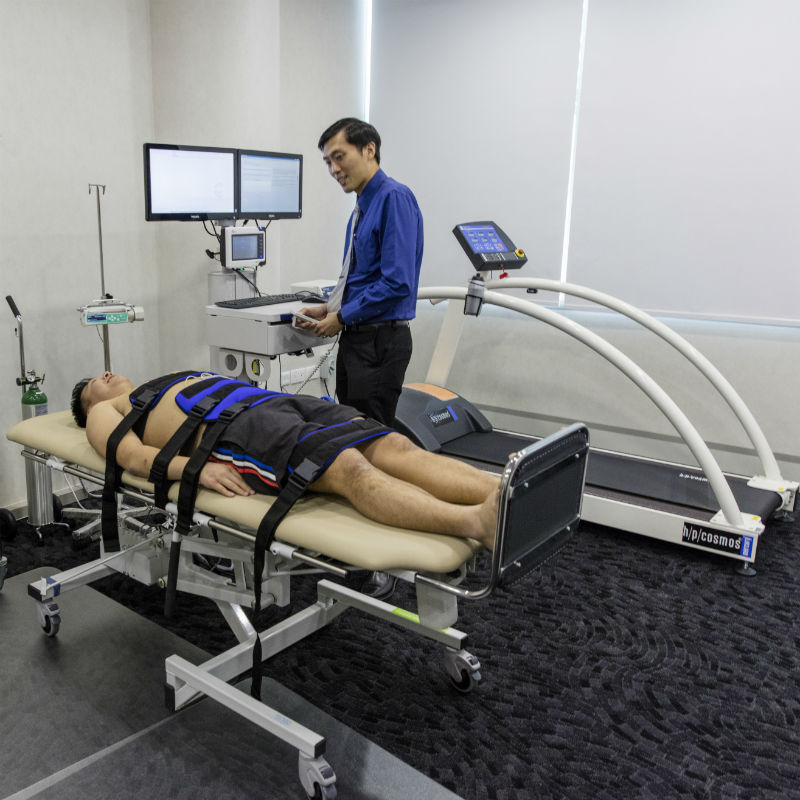
A tilt table test, occasionally called upright tilt testing, is a medical procedure often used to diagnose dysautonomia or syncope. Patients with symptoms of dizziness or lightheadedness, with or without a loss of consciousness (fainting), suspected to be associated with a drop in blood pressure or positional tachycardia are good candidates for this test. The procedure is useful to exclude vasovagal syncope by attempting to cause syncope by having the patient lie flat on a special table or bed while connected to ECG and blood pressure monitors. The table then creates a change in posture from lying to standing.
Your doctor may recommend a tilt table test if you’ve had repeated, unexplained episodes of fainting. A tilt table test may also be appropriate to investigate the cause of fainting if you’ve fainted only once, but another episode would put you at high risk of injury due to your work environment, medical history, age or other factors.
Before taking the test, the patient may be instructed to fast for a period before the test will take place and to stop taking any medications. On the day of the tilt table test, an intravenous line may be placed in case the patient needs to be given medications quickly; however, this may influence the results of the test and may only be indicated in particular circumstances.
A tilt table test can be done in different ways and be modified for individual circumstances. In some cases, the patient will be strapped to a tilt table lying flat and then tilted or suspended completely or almost completely upright (as if standing). Most of the time, the patient is suspended at an angle of 60 to 80 degrees. Sometimes, the patient will be given a drug, such as Glyceryl trinitrate (nitroglycerin) or isoproterenol, to create further susceptibility to the test. In all cases, the patient is instructed not to move. Symptoms, blood pressure, pulse, electrocardiogram, and sometimes blood oxygen saturation are recorded. The test either ends when the patient faints or develops other significant symptoms, or after a set period (usually from 20 to 45 minutes, depending on the facility or individualized protocol).
Cardiac Investigations
Cardiac Investigations
Cardiac Investigations
Cardiac Investigations
Cardiac Investigations
Cardiac Investigations
Cardiac Investigations
Cardiac Investigations
Cardiac Investigations
Cardiac Investigations
Cardiac Investigations
Dr Pipin Kojodjojo specializes in cardiac electrophysiology and management of heart rhythm disorders in both adolescents and adults.
Experienced in managing patients with atrial fibrillation and unexplained blackouts (syncope).
Dr Chuang Hsuan-Hung is a heart failure intensivist trained in advanced cardiovascular imaging. He specialises in heart failure and heart transplant intensive care.
Experienced in managing genetic heart disease, cardio-oncology and sports cardiology.
Dr Stanley Chia is an interventional cardiologist with a distinguished academic record.
He is skilled and experienced in managing complex cardiovascular disease and difficult coronary interventional procedures like stenting of the left main artery.
Dr Jeremy Chow is an electrophysiologist specialising in the implantation and management of electronic cardiac devices.
Experienced in arrhythmia management, stroke prevention and trained in procedures such as electrophysiology studies and ablations.
Dr Tan Chong Hiok is an interventional cardiolgist trained and specialises in stenting of the left main artery and chronic total occlusion.
He is experienced in managing complex cases in patients who have declined or are unsuitable for bypass surgery.
Dr Goh Ping Ping is an echocardiologist trained in imaging of the heart.
She is a strong advocate of preventive cardiology and awareness for women’s heart health. She manages a broad spectrum of cardiovascular disease including heart attack patients.
Dr Chan Wan Xian is a heart failure intensivist specialised in managing complex heart failure and patients with mechanical hearts.
Trained in cardiac imaging and she is experienced is treating women at risk of heart disease, especially during pregnancy.
Dr Edgar Tay is an interventional cardiologist specialised in structual heart disease, adult congenital and pulmonary hypertension.
Trained in procedures like TAVI, Mitralclip and pulmonary angioplasty for chronic thromboembolic pulmonary hypertension.
Dr Cliff Wong is an echocardiologist trained in imaging of the heart.
He specializes in cardiac imaging (echocardiography and cardiovascular computed tomography). Experienced in managing cardiomyopathy, heart failure, valvular heart diseases and cardio-oncology.